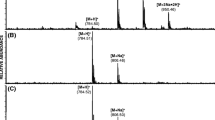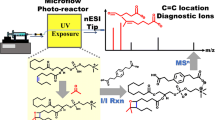Abstract
Lysoglycerophosphocholine lipids (lyso-GPC) are important intermediates in the synthesis and metabolism of glycerophosphocholine lipids which are major components of the cellular lipid bilayer. Significant differences in the collisional induced decomposition (CID) behavior were observed for each of the four different subtypes of lyso-GPC in both positive and negative ions. A major difference was observed in the initial CID product ions derived from lyso-GPC [M + H]+ with the loss of water that was very abundant for acyl lyso-GPC which have a fatty acid ester substituent at either the sn- 1 or sn- 2 positions. Loss of neutral water was not very prominent in the case of plasmenyl and plasmanyl lyso-GPC species. The mechanism responsible for this difference in behavior of lyso-GPC subtypes was consistent with a higher proton affinity of carboxyl carbonyl oxygen atoms and vinyl ether oxygen atoms found in acyl and plasmenyl lyso-GPC lipids, respectively, as compared to the carbinol oxygen atom common to all lyso-GPC species. Collisional activation of lyso-GPC negative ions [M − 15]− also revealed distinctive differences in product ions derived from acyl and ether lyso-GPC species. The acyl compounds showed the facile elimination of a highly stable carboxylate anion, whereas plasmenyl species underwent fragmentation with loss of a neutral aldehyde, likely a result of rearrangement involving the double bond in the vinyl ether moiety. The alkyl ether species (plasmanyl lyso-GPC lipids) did not undergo either decomposition reaction observed for the other lyso-GPC subtypes which permitted differentiation of acyl, plasmenyl, and plasmanyl lyso-GPC subtypes.
Similar content being viewed by others
References
Cullis, P. R.; Hope, M. J. In Biochemistry of Lipids, Lipoproteins and Membranes; Vance, D. E.; Vance, J., Eds., Elsevier Science: Amsterdam, 1991; pp 1–41.
The nomenclature of lipids. IUPAC-IUB commission on biochemical nomenclature. Biochem. J. 1978, 171, 21–35.
McKean, M. L.; Smith, J. B.; Silver, M. J. Phospholipid biosynthesis in human platelets. Formation of phosphatidylcholine from 1-acyl lysophosphatidylcholine by acyl-CoA: 1-acyl-sn-glycero-3-phosphocholine acyltransferase. J. Biol. Chem. 1982, 257, 11278–11283.
Kramer, R. M.; Deyken, D. Arachidonoyl transcylase in human platelets. Coenzyme A-independent transfer of arachidonate from phosphatidylcholine to lysoplasmenylethanolamine. J. Biol. Chem. 1983, 258, 13806–13811.
Kramer, R. M.; Sharp, J. D. Structure, function and regulation of Ca2+-sensitive cytosolic phospholipase A2 (cPLA2). FEBS Lett. 1997, 410, 49–53.
Farooqui, A. A.; Yang, H. C.; Rosenberger, T. A.; Horrocks, L. A. Phospholipase A2 and its role in brain tissue. J. Neurochem. 1997, 69, 889–901.
Goyal, J.; Wang, K.; Liu, M.; Subbaiah, P. V. Novel function of lecithin-cholesterol acyltransferase. Hydrolysis of oxidized polar phospholipids generated during lipoprotein oxidation. J. Biol. Chem. 1997, 272, 16231–16239.
Masuzawa, Y.; Sugiura, T.; Sprecher, H.; Waku, K. Selective acyl transfer in the reacylation of brain glycerophospholipids. Comparison of three acylation systems for 1-alk-1′-enylglycero-3-phosphoethanolamine, 1-acylglycero-3-phosphoethanolamine and 1-acylglycero-3-phosphocholine in rat brain microsomes. Biochim. Biophys. Acta 1989, 1005, 1–12.
Winker, J. D.; Fonteh, A. N.; Sung, C. M.; Heravi, J. D.; Nixon, A. B.; Chabot-Fletcher, M.; Griswold, D.; Marshall, L. A.; Chilton, F. H. Effects of CoA-independent transacylase inhibitors on the production of lipid inflammatory mediators. J. Pharmacol. Exp. Ther. 1995, 274, 1338–1347.
Chilton, F. H.; Murphy, R. C. Remodeling of arachidonate-containing phosphoglycerides within the human neutrophil. J. Biol. Chem. 1986, 261, 7771–7777.
Chilton, F. H.; Fonteh, A. N.; Sung, C. M.; Hickey, D. M.; Torphy, T. J.; Mayer, R. J.; Marshall, L. A.; Heravi, J. D.; Winkler, J. D. Inhibitors of CoA-independent transacylase block the movement of arachidonate into 1-ether-linked phospholipids of human neutrophils. Biochemistry 1995, 34, 5403–5410.
Pascher, I.; Sundell, S.; Hauser, H. Polar group interaction and molecular packing of membrane lipids. The crystal structure of lysophosphatidylethanolamine. J. Mol. Biol. 1981, 153, 807–824.
Small, L. M. The Physical Chemistry of Lipids: Handbook of Lipid Research; Plenum: New York, 1986; pp 475–521.
Chernomordik, L. V.; Voegl, S. S.; Sokoloff, A.; Onaran, H. O.; Leikina, E. A.; Zimmerberg, J. Lysolipids reversibly inhibit Ca(2+)-, GTP- and pH-dependent fusion of biological membranes. FEBS Lett. 1993, 318, 71–76.
Corr, P. B.; Saffitz, J. E.; Sobel, B. E. Lysophospholipids, long chain acylcarnitines and membrane dysfunction in the ischaemic heart. Basic Res. Cardiol. 1987, 82, 199–208.
Sakai, M.; Miyazaki, A.; Hakamata, H.; Kodama, T.; Suzuki, H.; Kobori, S.; Shichiri, M.; Horiuchi, S. The scavenger receptor serves as a route for internalization of lysophosphatidylcholine in oxidized low density lipoprotein-induced macrophage proliferation. J. Biol. Chem. 1996, 271, 27346–27352.
Ngwenya, B. Z.; Yamamoto, N. Activation of peritoneal macrophages by lysophosphatidylcholine. Biochim. Biophys. Acta 1985, 839, 9–15.
Voegl, S. S.; Leikina, E. A.; Chernomordik, L. V. Lysophosphatidylcholine reversibly arrests exocytosis and viral fusion at a stage between triggering and membrane merger. J. Biol. Chem. 1993, 268, 25764–25768.
Kerwin, J. L.; Tuininga, A. R.; Ericsson, L. H. Identification of molecular species of glycerophospholipids and sphingomyelin using electrospray mass spectrometry. J. Lipid Res. 1994, 35, 1102–1114.
Han, X.; Gross, R. W. Electrospray ionization mass spectroscopic analysis of human erythrocyte plasma membrane phospholipids. Proc. Natl. Acad. Sci. USA 1994, 91, 10635–10639.
Kim, H. Y.; Wang, T. C.; Ma, Y. C. Liquid Chromatography/mass spectrometry of phospholipids using electrospray ionization. Anal. Chem. 1994, 66, 3977–3982.
Weintraub, S. T.; Pinckard, R. N.; Hail, M. Electrospray ionization for analysis of platelet-activating factor. Rapid Commun. Mass Spectrom. 1991, 5, 309–311.
Harrison, K. A.; Murphy, R. C. Negative electrospray ionization of glycerophosphocholine lipids: Formation of [M − 15]− ions occurs via collisional decomposition of adduct anions. J. Mass Spectrom. 1995, 30, 1772–1773.
Khaselev, N.; Murphy, R. C. Susceptibility of plasmenyl glycerophosphoethanolamine lipids containing arachidonate to oxidative degradation. Free Radical Biol. Med. 1999, 26, 275–284.
Mason, J. T.; Broccoli, A. V.; Huang, C. A method for the synthesis of isomerically pure saturated mixed-chain phosphatidylcholines. Anal. Biochem. 1981, 113, 96–101.
Huang, Z.-H.; Gage, D. A.; Sweeley, C. C. Characterization of diacylglycerylphosphocholine molecular species by FAB-CAD-MS/MS: A general method not sensitive to the nature of the fatty acyl groups. J. Am. Soc. Mass Spectrom. 1992, 3, 71–78.
Fenwick, G. R.; Eagles, J.; Self, R. Fast atom bombardment mass spectrometry of intact phospholipids and related compounds. Biomed. Mass Spectrom. 1983, 10, 382–393.
Jensen, N. J.; Tomer, K. B.; Gross, M. L. Fast atom bombardment and tandem mass spectrometry of phosphatidylserine and phosphatidylcholine. Lipids 1986, 21, 580–588.
Cole, M. J.; Enke, C. G. Direct determination of phospholipid structures in microorganisms by fast atom bombardment triple quadrupole mass spectrometry. Anal. Chem. 1991, 63, 1032–1038.
Murphy, R. C. Mass Spectrometry of Lipids: Handbook of Lipid Research; Plenum: New York, 1993.
Lias, S. G.; Bartmess, J. E.; Liebman, J. F.; Holmes, J. L.; Levin, R. D.; Mallard, W. G. Gas-phase ion and neutral thermochemistry. J. Phys. Chem. Ref. Data 1988, 17, 1–861.
Author information
Authors and Affiliations
Corresponding author
Rights and permissions
About this article
Cite this article
Khaselev, N., Murphy, R.C. Electrospray ionization mass spectrometry of. J Am Soc Mass Spectrom 11, 283–291 (2000). https://doi.org/10.1016/S1044-0305(99)00158-0
Received:
Revised:
Accepted:
Issue Date:
DOI: https://doi.org/10.1016/S1044-0305(99)00158-0




